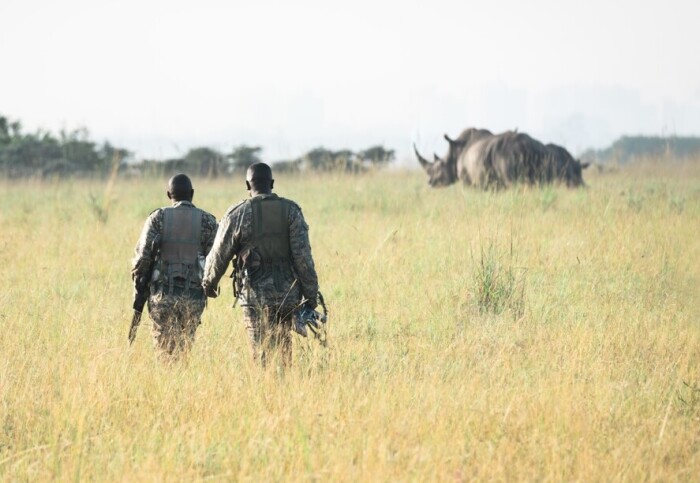What Africa needs to do to meet biodiversity targets

Advanced technologies, education, and channeling local and indigenous knowledge could help African nations protect their unique nature.
The 30 by 30 target set by the Convention on Biological Diversity (CBD) aims to protect 30% of the land and seascape by 2030.
We need biodiversity scientists highlighting how important biodiversity is ... which would help in bridging the gap between scientific and non-scientific communities. Professor Vincent Savolainen
Governments around the world have fallen behind on these targets, and African governments are no exception. The African Union (AU) member states currently spend an average of 0.43% of their GDP on research and sustainable development, below the global average of 1%. So far, they have only protected 19% of the landscape and 17% of the seascape.
With only five years to meet this target an international team, led by Professor Vincent Savolainen from Imperial and Dr Simmy Bezeng from the University of Johannesburg and RSPB, looked at how government bodies and biodiversity experts must collaborate to increase conservation efforts.
Their recent paper, published in the journal Philosophical Transactions of the Royal Society, brings together recommendations from conservation researchers and practitioners to show governments what kind of support they should be providing to achieve these targets. Recommendations include facilitating the use of advanced technology, redirecting government budgets towards conservation, education and legal frameworks, and channeling indigenous and local knowledge.
Professor Savolainen and Dr Bezeng talked us through their recommendations.
Technology, data, and resources
Many African institutions face data and resource limitations, which makes it difficult for them to document and manage biodiversity. By improving data collection and sharing methods, the team say researchers could better monitor ecological communities and therefore determine strategies to increase protection in those areas.
Professor Savolainen said: “High throughput recording hardware, such as camera traps or audio recorders, can do an amazing job of identifying areas of high biodiversity, collecting rich multi-dimensional data and making discoveries. So, it is essential that policy and decision makers are aware of these local success stories. The proof is in the pudding!”
One example success story occurred in Algeria. Between 2008 and 2021, infrared camera traps detected the presence of two sub-species formerly believed to have gone extinct: the Saharan Cheetah and the Atlas Leopard. These kinds of discoveries help to identify both protected and unprotected nature areas, link them together, and facilitate discussion around securing laws that keep them safe.
Investing in education and training
Education underpins the success of biodiversity conservation by fostering awareness, encouraging sustainable practices, and empowering communities to protect natural ecosystems. A community-led approach would shift funding and training in the direction of African scholars, practitioners, chairs at African universities, and national parks. By investing in education, interest in biodiversity increases.
Professor Savolainen said: “We are taking the initiative to show how important these issues are; getting governments to realise how important education is and put money into it, even when just starting at local stages with schools.”
Countries like South Africa and Kenya, who are part of the subsidiary body for the CBD, are really pushing for this, for example by setting up centres for the implementation of CBD targets.
Dr Bezeng said: “Centres of research excellence like this create a hub for biodiversity conservation and provide a central point for data sharing, research, training, and funding opportunities. They streamline access to resources for aspiring African researchers, and countries like South Africa and Kenya are really pushing for this.”
Indigenous and local minds
Biodiversity experts are often local and indigenous people. Strategies combining scientific research with local ecological knowledge are often the most efficient and valuable, say the team. Indigenous peoples and local community (IPLCs) roles lead to effective outcomes when supported by legislation and policy.
However, it’s important to address sensitivity towards indigenous and local communities. There are often concerns among locals over their livelihoods. But, as Professor Savolainen pointed out: “You should be able to make money without decreasing the livelihoods of people. You can do things differently. You can sustain your livelihood, while also sustaining biodiversity.”
In a sense, this also means ensuring adequate education around sustainability and making it accessible for locals.
A really great example of this is the establishment of an organic processing centre in Ghana. It has provided jobs for women from seven communities, enabled the export of processed shea products, and led to conservation agreements between the Community Resource Management Area (CREMAs) initiative and The Savannah Fruits Company. This agreement amounts to over £$28,700 annually and means the community women’s group gets additional bonuses for their organic shea butter production.
How will the findings be used?
The team hope these findings will help translate complex biodiversity issues into concrete recommendations for government bodies, policy makers, and the public.
This research was assisted by 25 African conservationists and researchers, some of which attended the COP16 global biodiversity meeting in Colombia and are involved with high-level negotiations with governments. Dr Bezeng explained: “This event in Colombia gives us a good advantage to put out some of these points, and when we meet with the co-authors, we can see how they can push some of these recommendations that we put forward.”
Professor Savolainen concluded: “The findings are a great way to get officials to understand and care about biodiversity and to illustrate how biodiversity loss impacts our lives. They help to communicate that climate change indicators, like floods and bushfires, are not the only issue.
“We need biodiversity scientists highlighting how important biodiversity is and how things like zoonotic diseases – ones originating in animals – might also be linked to biodiversity changes, which would help in bridging the gap between scientific and non-scientific communities.”
---
'An African Perspective to Biodiversity Conservation in the 21st Century' by Bezeng et al. is published in Philosophical Transactions of the Royal Society.
Article text (excluding photos or graphics) © Imperial College London.
Photos and graphics subject to third party copyright used with permission or © Imperial College London.
Reporter
Press Office
Communications and Public Affairs
- Email: press.office@imperial.ac.uk
